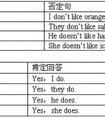My dad can _____ chess well, _____ I can't.[ ]A. play; butB. playing; butC. play; and-六年级英语
题文
| My dad can _____ chess well, _____ I can't. |
| [ ] |
| A. play; but B. playing; but C. play; and |
答案
| A |
据专家权威分析,试题“My dad can _____ chess well, _____ I can't.[ ]A. play; b..”主要考查你对 实义动词,连词 等考点的理解。关于这些考点的“档案”如下:
实义动词连词
考点名称:实义动词
实义动词:
与系动词是相对的,系动词亦称连系动词,作为系动词,它本身有词义,但不能单独用作谓语,后边必须跟表语(亦称补语),构成系表结构说明主语的状况、性质、特征等情况。
实义动词意思完全,能独立用作谓语。
实义动词有及物动词和不及物动词(及物动词是指后面要求有直接宾语的动词;
不及物动词指后面不需要跟宾语的动词)即行为动词,表示动作的动词。
实义动词(又称行为动词):表示行为或状态,有完全的词义,能独立作谓语。
如:I go to school by bus. 我乘公交车去上学。
The students clean their classroom every day. 学生每天打扫教室。- 及物动词:
后面必须跟宾语,意义才完整的实义动词,叫做及物动词(transitive verb)。
英语中的及物动词有:interest,worry,guss,please,surprise,love等
例如:I believe that the committee will consider our suggestion.我相信委员会将会考虑我们的建议。
“How long can I keep the book ”Harry asked.哈里问:“这本书我可以借多久?”
Dr. Bethune set us a good example. 白求恩大夫给我们树立了好榜样。
Crude oil contains many useful substances.原油含有许多有用的物质。
不及物动词:
本身意义完整,后面不用跟宾语的实义动词,叫做不及物动词(intransitive verb)。
Birds fly.鸟会飞。
It happened in June 1932.这件事发生于一九三二年六月。
My watch stopped.我的表停了。
She spoke at the meeting yesterday evening. 她在昨天晚上的会上发了言。
兼作及物动词和不及物动词:
英语里有不少实义动词可以兼作及物动词和不及物动词。
这样的动词又有两种不同的情况:
a)兼作及物动词和不及物动词时,意义不变。试比较:
Shall I begin at once?我可以立刻开始吗?(begin作不及物动词)
She began working as a librarian after she left school.她毕业后当图书馆管理员。(began作及物动词)
When did they leave Chicago?他们是什么时候离开芝加哥的?(leave 作及物动词)
They left last week. 他们是上周离开的。(left 作不及物动词)
b)兼作及物动词和不及物动词时,有时意义不尽相同。如:
Wash your hands before meals.饭前要洗手。
Does this cloth wash well? 这布经得起洗吗?
与汉语的比较:
有时英语动词的及物和不及物的用法,与汉语的用法完全不一样,请注意下列两种情况:
a)有的动词在英语里只能用作不及物动词,而汉语则可用作及物动词,如arrive到达,agree同意,listen听。英语里这些动词后面常接介词。如:
We arrived at the railway station at noon.我们于中午到达火车站。(at不能省去)(比较:We reached the railway station at noon.)
Everybody listened to the lecture with great interest.每个人都很有兴趣地听讲课。(to不可省去)(比较:We all heard the lecture.)
Do they agree to the plan?他们同意这个计划吗?(to不可以省去)
b)有的动词在英语里能用作及物动词,而在汉语里则不能用作及物动词,如serve为…服务。
Our children are taught to serve the people wholeheartedly.我们的儿童被教以全心全意为人民服务 - 特殊实义动词:
英语动词很多既是及物动词又是不及物动词,如
close, begin, study, leave, work等。
①The post office closes at 9:00 p. m.邮局晚上9点关门。
②Close the window,please.请关窗。
③Shall we begin now?我们现在开始吗?
④ Bill began working as a sailor after he left school.比尔毕业后当水手。
⑤They left yesterday.他们昨天离开的。
⑥When did you leave Washington?你什么时候离开华盛顿的?
⑦The students study hard.这些学生学习努力。
⑧The students study English and German.这些学生学习英语和德语。
⑨He works in a supermarket.他在一家超市工作。
⑩He works the machine on Mondays.他星期一操作这台机器。
考点名称:连词
- 连词:
是连接单词、短语或句子的一种词,连词不能独立担任句子成份,而只起连接作用。
连词可分为两大类:并列连词和从属连词。 - 连词的用法:
一、并列连词:
1.and连接单词MybrotherandIstudyinthesameschool。
连接短语Ourknowledgemaycomefromthebooksandfrompractice。
连接句子Wearesingingandtheyaredancing。
2but但是/而是Ihaveapenbutnopencil.or或者Willyougotherebybusoronfoot
3.nothingbut除了,只有Ididnothingbutwatchit。
4.or表示否则Hurryuporyouwillbelate。
5.for表示因为Heisgoodatmathforhestudiesharderthanothers。
二、从属连词:
1.after表示“时间”,在…之后
AfterIfinishedtheschool,Ibecameaworkerinthefactory。
2.although/though表示让步,“尽管”Althoughsheisyoung,sheknowsalot。
3.as表示时间,“当…时”,方式“象…”,原因,“由于、因为”让步,“尽管、虽然”
Asitwaslate,wemustgonow。
4.asif/asthough表方式,“似乎、好像”
Hetoldissuchastoryasthoughhehadbeentherebefore。
5.aslongas/solongas表条件,“只要”AslongasIamfree,I’llgotohelpyou。
6.assoonas表时间,“一…就…”IwillphoneyouassoonasIcomeback。
7.because表原因,“因为”IhavetostayinbedbecauseIamill。
8.before表时间,“在…之前“Youshouldthinkmorebeforeyoudoit。 比较and和or
①并列结构中,or通常用于否定句,and用于肯定句。
②但有时and 也可用于否定句。请注意其不同特点:
There is no air or water in the moon.
There is no air and no water on the moon.
在否定中并列结构用or 连接,但含有两个否定词的句子实际被看作是肯定结构,因此要用and。
比较so和 such
其规律由so与such的不同词性决定。
such 是形容词,修饰名词或名词词组;
so是副词,只能修饰形容词或副词;
so 还可与表示数量的形容词many,few,much, little连用,形成固定搭配。
so + adj. such + a(n) + n.
so + adj. + a(n) + n. such + n. (pl.)
so + adj. + n. (pl.) such +n. (pl.)
so + adj. + n. [不可数] such +n. [不可数]
so foolish such a fool
so nice a flower such a nice flower
so many/ few flowers such nice flowers
so much/little money. such rapid progress
so many people such a lot of people
so many 已成固定搭配,a lot of 虽相当于 many,但 a lot of 为名词性的,只能用such搭配。
so…that与such…that之间的转换既为 so与such之间的转换。
- 最新内容
- 相关内容
- 网友推荐
- 图文推荐
| [家长教育] 孩子为什么会和父母感情疏离? (2019-07-14) |
| [教师分享] 给远方姐姐的一封信 (2018-11-07) |
| [教师分享] 伸缩门 (2018-11-07) |
| [教师分享] 回家乡 (2018-11-07) |
| [教师分享] 是风味也是人间 (2018-11-07) |
| [教师分享] 一句格言的启示 (2018-11-07) |
| [教师分享] 无规矩不成方圆 (2018-11-07) |
| [教师分享] 第十届全国教育名家论坛有感(二) (2018-11-07) |
| [教师分享] 贪玩的小狗 (2018-11-07) |
| [教师分享] 未命名文章 (2018-11-07) |




![We ____________together. [ ]A. read a bookB. sleep-一年级英语](http://www.00-edu.com/d/file/ks/4/1/60/2019-08-28/smallea4b9832081df346c35e7fe937dd76101566947664.gif)
![What's he doing? He's ___________. [ ]A. readingB. drawing-四年级英语](http://www.00-edu.com/d/file/ks/4/1/60/2019-08-28/small07eb195a0f249b46b2d76d31ab9e28261566947675.jpg)
